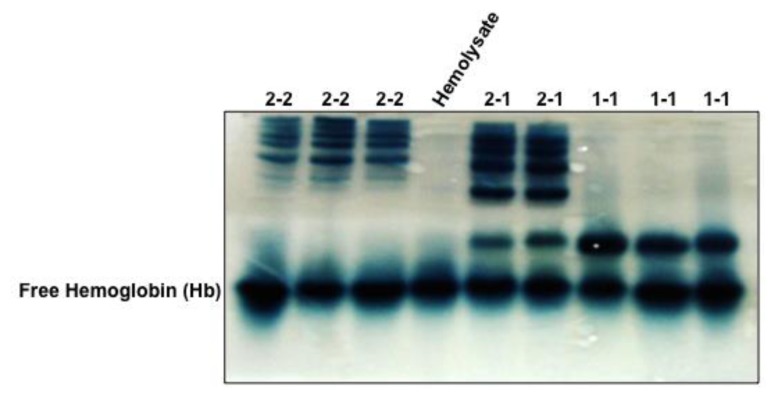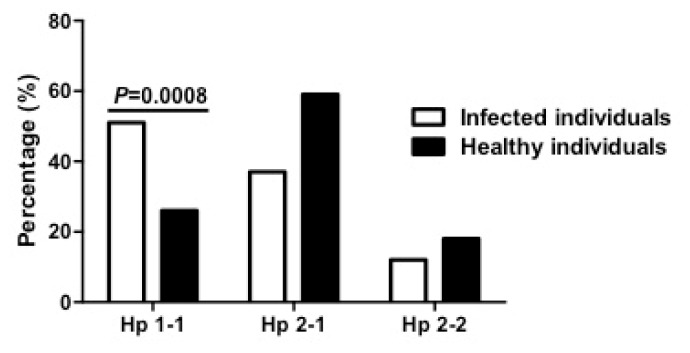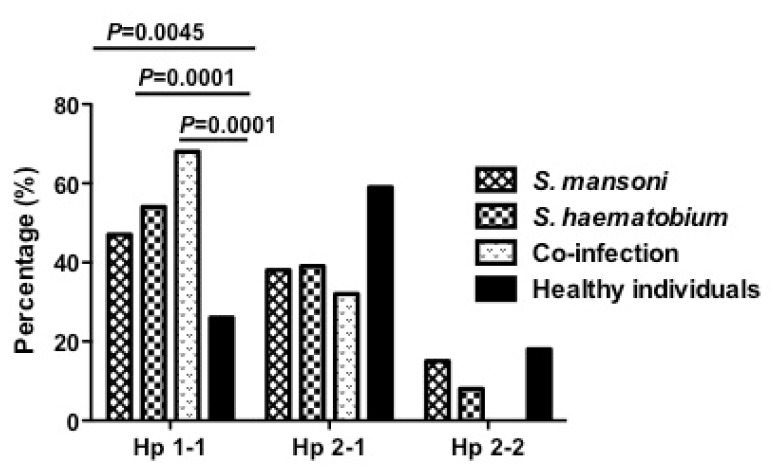Abstract
Haptoglobin (Hp) is an acute phase protein that binds the free hemoglobin (Hb), thus preventing iron loss and renal damage. Hp also has antioxidative and immunomodulatory properties. Three Hp phenotypes have been identified in human: Hp1-1, Hp2-1, and Hp2-2. Hp polymorphisms have been related to susceptibility of various diseases. In this study, we aimed to assess the possible association of Hp phenotypes polymorphism to Schistosoma parasites infection in central Sudan. We have investigated the Hp phenotypes polymorphism distribution in the serum of 125 (93 S. mansoni, 13 S. haematobium and 19 infected with both “co-infection”) parasitologically confirmed infected individuals and 208 healthy individuals served as control. Hp phenotypes have been determined by polyacrylamide gel electrophoresis followed by benzidine staining. Our study revealed that Hp1-1 percentage frequency was significantly higher in infected individuals than healthy control individuals 51% and 26% respectively. Our data suggest that Hp1-1 phenotype may upsurge the susceptibility to Schistosoma parasites infection in central Sudan.
Keywords: Haptoglobin, Polymorphism, Schistosoma, Infection and Susceptibility
Introduction
Haptoglobin (Hp) is an acute phase plasma protein with a high affinity-binding to free hemoglobin (Hb) and subsequently responsible for its removal from the circulation.1,2 The Hp gene has been identified in all mammals and in humans it has been characterized by a genetic polymorphism leading to three phenotypes: Hp 1-1, Hp 2-1 and Hp 2-2.3 Early studies demonstrated that the distribution of the three phenotypes varies worldwide depending on racial origin in particular among races and tribes in Africa suggesting such critical point must be taken into consideration in all Hp association studies with infection and diseases progression.4,5
Hp phenotypes revealed different anti-inflammatory, immunomodulatory and anti-oxidative properties that have clinical consequences in different pathologies including cancer, infections and also the lifespan expectancy.6–9 As an immunomodulatory, Hp1-1 and Hp2-1 have been reported to affect the T-lymphocyte functions by direct binding to the resting and activated CD4+ and CD8+ T lymphocytes resulting in a strong suppression of induced T-cell proliferation.10 Furthermore, Hp1-1 and Hp2-1 display strong in vitro inhibitory effect on Th2 cytokine release and subsequently promote Th1 activation over Th2 activation in vivo.11 Haptoglobin also acts as a potent antioxidant, oxidative damage to DNA induced by hydrogen peroxide have been investigated among the three Hp phenotypes and finding revealed that Hp1-1 has least DNA damage compared to Hp2-1 and Hp2-2.12
Schistosomiasis or bilharzia is an infection caused by trematodes (blood flukes) and is widespread in Sudan, especially in the major irrigation systems of the Gezira agriculture scheme between the Blue and White Nile Rivers.13 Infection in Sudan mainly belongs to two species of the genus Schistosoma: S. mansoni which cause intestinal schistosomiasis and S. haematobium that causes urinary schistosomiasis.13,14 The proportion of the population infected with schistosomiasis is growing in the endemic areas. The disease has very serious socioeconomic consequence e.g. decreasing work capacity, restricting marriage and occupational mobility.15 Some studies in Sudan revealed the association of Hp phenotypes polymorphism with infectious and non-infectious diseases.16–18 Therefore, in this study, we investigated the possible association of Hp phenotypes and susceptibility to Schistosoma parasites infection acquisition in central Sudan. Our finding suggests that the individuals with Hp1-1 are at higher risk of attaining the Schistosoma infection compared to individuals with other Hp phenotypes.
Materials and Methods
Study area, population and samples collection
This study was conducted in two permanent agricultural camps in Gezira irrigated scheme, central Sudan which is endemic with both S. mansoni and to less extent S. haematobium parasitic infection. The camps are without water supply systems, and their main source of water is the canal. The inhabitants of these camps are originally from western Sudan. The majorities of the populations in the camps are agricultural field laborers and were equally exposed to schistosome infection. After obtaining a written informed consent from all participants, the standard microscopic parasitological examination was performed to detect the Schistosome eggs in stool and urine samples which confirm the infection and the type of Schistosoma parasite infection 19. Blood was collected from125 infected individuals (93 S. mansoni, 13 S. haematobium and 19 infected with both “co-infection”) and 208 healthy individuals served as control. Serum was separated and obtained from all blood samples by centrifugation at 2000 rpm for 15 min and stored at −70°C.
Identification of Haptoglobin (Hp) phenotypes
Haptoglobin (Hp) phenotypes were separated in discontinuous polyacrylamide gel electrophoresis (non-reducing) according to Davis and Orenstein 20 method and modified by Linke 21 and was applied using the Mini- V 8.10 system (BRL, Life Technologies Inc, Gaithersburg, USA). In brief, 10 μl of serum was mixed with 4 μl of erythrocyte hemolysate which contains free hemoglobin (Hb) and 5 μl loading buffer, then 10 μl from each prepared mixture was added to each well of 4.7% polyacrylamide gel. After completion of the run, the gel was stained for 10-l5 min with benzidine stain.
Statistical analysis
Statistical significance was assessed by Chi-square test to determine the association of Hp phenotypes distribution among infected individuals and healthy control individuals. Statistical analysis and charts preparation were performed using Graphpad Prism version 5.0 (GraphPad Software Inc.).
Results and discussion. Disparities in infection acquisition among individuals to prevailing endemic pathogens obviously demonstrate the significance of the host genetic variability to pathogens vulnerability.22,23 Since the identification of haptoglobin (Hp) molecular heterogeneity in humans, many reports have associated the Hp phenotypes polymorphism to susceptibility and progression of various diseases such as cancer, diabetes mellitus, liver disorders and infections including malaria, Chagas disease, and HIV.6,24–28 In this study, we have aimed to assess the possible association of Hp phenotypes polymorphism to the susceptibility to Schistosoma parasites infection acquisition in central Sudan, which is an endemic area of schistosomiasis. Serum was collected from 125 parasitologically confirmed infected individuals either with S. mansoni (93), S. haematobium (13) or with co-infection (19) and 208 healthy individuals served as control. Hp phenotypes determined by separation by polyacrylamide gel electrophoresis followed by benzidine staining (Figure 1). As described previously by Langlois and Delanghe,3 Hp phenotypes have very well distinctive patterns in complex with the Hb. Hp1-1 appeared as one band with low molecular weight, Hp2-1 has multiple bands with high molecular weight in addition to the Hp1-1 band while Hp2-2 has only the multiple bands with high molecular weight but no Hp1-1 band (Figure 1). Among overall infected individuals, we found that the Hp1-1 phenotype was higher and significantly distributed among infected individuals compared to healthy control, 51% to 26% respectively (Figure 2). However Hp2-1 phenotype was less frequent in the infected individuals compared to healthy control, 37%, 59% respectively (Figure 2). Overall, the Hp2-2 phenotype was the least distributed phenotype in both infected and healthy individuals with no apparent difference among infected individuals and healthy control (12%, 18% respectively) (Figure 2). Moreover, we have analyzed the Hp phenotypes distribution among individuals infected either with S. mansoni, S. haematobium or both “Co-infection” separately (Figure 3). Comparing Hp phenotypes patterns in the overall Schistosoma-infected individuals and healthy controls we found that the Hp1-1 phenotype is more frequent in each infected group irrespective to the type of infection suggesting that individuals with Hp1-1 phenotype may at higher risk of Schistosoma parasites infection acquisition compared to those carrying Hp2-1 or Hp2-2.
Figure 1.
Determination of haptoglobin (Hp) phenotypes (Hp 1-1, 2-1 and 2-2) after supplementation with free hemoglobin (Hb) from hemolysate to form Hp/Hb complex and then separated by polyacrylamide gel followed by benzidine staining. Free hemoglobin indicated and in parallel hemolysate runs as control.
Figure 2.
Overall distribution percentage of different Hp phenotypes among individuals infected with Schistosoma parasites and healthy control individuals. Value of p<0.05 considered significant.
Figure 3.
Overall distribution percentage of different Hp phenotypes among individuals infected either with S. mansoni, S. haematobium or both “Co-infection” compared to healthy control individuals. Value of p<0.05 considered significant.
It has been demonstrated that Hp 1-1 possess differentially and extremely greater antioxidant activity than Hp 2-1 and 2-2 which may reflect in clinical implications in various diseases.29 Indeed Hp1-1 have been associated with malaria infection in some African countries such as Ghana, Cameroon, and Sudan as well.18,28,30 Some early studies in Sudan also reported that Hp1-1 phenotype is associated with liver disorders including hepatitis B virus (HBV).17,16 Interestingly a significant increase of Hp concentration following the Schistosoma mansoni cercariae infection in both mice and baboons have been observed and linked to schistosomiasis infection and pathogenesis.31–33 Our current study findings attest the involvement of Hp in schistosoma infection in particular Hp1-1. Intriguingly Cook and his colleagues found that Schistosoma adult worm expresses antioxidant enzymes to neutralize the effects of reactive oxygen and nitrogen species as a mechanism in evading immune killing.34 Moreover, Hp1-1 and Hp2-1 playing a critical role in modulating the Th1/Th2 balance and promoting a dominant Th1 cellular response over Th2.10,11 Th1/Th2 balancing is crucial to fight and combat schistosoma infection by the host as after the penetration of cercariae, and before the onset of egg deposition the immune response is primarily of Th1 type (promoting cellular immunity) and directed against worm antigens. At the onset of egg production, the immune response switches to Th2 type, promoting an antibody response directed preferentially against highly immunogenic egg glycans.35
Collectively we suggest that the potent antioxidative activity of the Hp1-1 phenotype may neutralize the effects of reactive oxygen and nitrogen species and therefore support the early stage of Schistosoma parasite in evading immune killing and eventually facilitated the establishment of Schistosoma infection compared to individuals with Hp2-1 or Hp2-2 phenotype. Suppression of Th2 response by Hp1-1 could contribute as well to infection and disease progression.
Conclusions
Our finding demonstrates that individuals with Hp1-1 phenotype may at higher risk of Schistosoma infection acquisition compared to individuals with Hp2-1 or Hp2-2 phenotype. More studies are needed in the future to validate the insight mechanism of Hp1-1 in schistosoma infection.
Acknowledgements
We would like to thank all participants for agreed to be involved in this study. Our gratitude extended to the Department of Immunology and Biotechnology members of TMRI. This work was supported by the National Centre for Research (NCR), Ministry of Higher Education and Scientific Research-Sudan.
Footnotes
Competing interests: The authors have declared that no competing interests exist.
References
- 1.Alayash AI. Haptoglobin: Old protein with new functions. Clinica Chimica Acta. 2011;412:493–8. doi: 10.1016/j.cca.2010.12.011. https://doi.org/10.1016/j.cca.2010.12.011 [DOI] [PubMed] [Google Scholar]
- 2.Fagoonee S, Gburek J, Hirsch E, Marro S, Moestrup SK, Laurberg JM, et al. Plasma protein haptoglobin modulates renal iron loading. Am J Pathol. 2005;166(4):973–83. doi: 10.1016/S0002-9440(10)62319-X. https://doi.org/10.1016/S0002-9440(10)62319-X. [DOI] [PMC free article] [PubMed] [Google Scholar]
- 3.Langlois MR, Delanghe JR. Biological and clinical significance of haptoglobin polymorphism in humans. Clinical Chemistry. 1996;42:1589–600. [PubMed] [Google Scholar]
- 4.Carter K, Worwood M. Haptoglobin: A review of the major allele frequencies worldwide and their association with diseases. International Journal of Laboratory Hematology. 2007;29:92–110. doi: 10.1111/j.1751-553X.2007.00898.x. https://doi.org/10.1111/j.1751-553X.2007.00898.x [DOI] [PubMed] [Google Scholar]
- 5.Constans J, Viau M, Gouaillard C, Clerc a. Haptoglobin polymorphism among Saharian and West African groups. Haptoglobin phenotype determination by radioimmunoelectrophoresis on Hp O samples. Am J Hum Genet. 1981;33(4):606–16. [PMC free article] [PubMed] [Google Scholar]
- 6.Speeckaert R, Brochez L, Lambert J, van Geel N, Speeckaert MM, Claeys L, et al. The haptoglobin phenotype influences the risk of cutaneous squamous cell carcinoma in kidney transplant patients. J Eur Acad Dermatol Venereol. 2012;26(5):566–71. doi: 10.1111/j.1468-3083.2011.04112.x. https://doi.org/10.1111/j.1468-3083.2011.04112.x. [DOI] [PubMed] [Google Scholar]
- 7.Kasvosve I, Speeckaert MM, Speeckaert R, Masukume G, Delanghe JR. Haptoglobin polymorphism and infection. Advances in clinical chemistry. 2010;50:23–46. doi: 10.1016/s0065-2423(10)50002-7. https://doi.org/10.1016/S0065-2423(10)50002-7 [DOI] [PubMed] [Google Scholar]
- 8.Mahmud SM, Koushik A, Duarte-Franco E, Costa J, Fontes G, Bicho M, et al. Haptoglobin phenotype and risk of cervical neoplasia: A case-control study. Clin Chim Acta. 2007;385(1–2):67–72. doi: 10.1016/j.cca.2007.06.020. https://doi.org/10.1016/j.cca.2007.06.020. [DOI] [PubMed] [Google Scholar]
- 9.Napolioni V, Giannì P, Carpi FM, Concetti F, Lucarini N. Haptoglobin (HP) polymorphisms and human longevity: A cross-sectional association study in a Central Italy population. Clin Chim Acta. 2011;412(7–8):574–7. doi: 10.1016/j.cca.2010.12.006. https://doi.org/10.1016/j.cca.2010.12.006. [DOI] [PubMed] [Google Scholar]
- 10.Sadrzadeh SM, Bozorgmehr J. Haptoglobin phenotypes in health and disorders. American journal of clinical pathology. 2004;121(Suppl):S97–104. doi: 10.1309/8GLX5798Y5XHQ0VW. https://doi.org/10.1309/8glx5798y5xhq0vw [DOI] [PubMed] [Google Scholar]
- 11.Arredouani M, Matthijs P, Van Hoeyveld E, Kasran A, Baumann H, Ceuppens JL, et al. Haptoglobin directly affects T cells and suppresses T helper cell type 2 cytokine release. Immunology. 2003;108(2):144–51. doi: 10.1046/j.1365-2567.2003.01569.x. https://doi.org/10.1046/j.1365-2567.2003.01569.x. [DOI] [PMC free article] [PubMed] [Google Scholar]
- 12.Moreira L, Miranda-Vilela A, Silva I, Akimoto A, Klautau-Guimarães M, Grisolia C, et al. Antioxidant effect of haptoglobin phenotypes against DNA damage induced by hydrogen peroxide in human leukocytes. Genet Mol Res Mol Res. 2009;8(81):284–90. doi: 10.4238/vol8-1gmr569. https://doi.org/10.4238/vol8-1gmr569. [DOI] [PubMed] [Google Scholar]
- 13.Deganello R, Cruciani M, Beltramello C, Duncan O, Oyugi V, Montresor A. Schistosoma haematobium and Schistosoma mansoni among children, Southern Sudan. Emerg Infect Dis. 2007;13:1–5. doi: 10.3201/eid1310.070356. [DOI] [PMC free article] [PubMed] [Google Scholar]
- 14.Elhag SM, Abdelkareem EA, Yousif AS, Frah EA, Mohamed AB. Detection of schistosomiasis antibodies in urine patients as a promising diagnostic maker. Asian Pac J Trop Med. 2011;4(10):773–7. doi: 10.1016/S1995-7645(11)60192-2. https://doi.org/10.1016/S1995-7645(11)60192-2. [DOI] [PubMed] [Google Scholar]
- 15.Sleigh A, Li Xueming, Jackson S, Huang K. Eradication of schistosomiasis in Guangxi, China. Part 3. Community diagnosis of the worst-affected areas and maintenance strategies for the future. Bull World Health Organ. 1998;76(6):581–90. [PMC free article] [PubMed] [Google Scholar]
- 16.Ibrahim N, Baleela R. Association of Hp 1-1 with liver disorders among Sudanese patients. Am J Sci Ind Res. 2012;3(6):403–5. https://doi.org/10.5251/ajsir.2012.3.6.403.405. [Google Scholar]
- 17.Baleela Rania MH, Ibrahim Nada E, Osman Omran F, Elagib2 Atif A. Distribution of Haptoglobin Phenotypes among Patients with HIV/AIDS, Hepatitis B, Liver Cirrhosis and Chronic Renal Failure in Sudan. Sudan J Sci. 2012;5(1):1–6. [Google Scholar]
- 18.Elagib AA, Kider AO, Åkerström B, Elbashir MI. Association of the haptoglobin phenotype (1–1) with falciparum malaria in Sudan. Trans R Soc Trop Med Hyg. 1998;92(3):309–11. doi: 10.1016/s0035-9203(98)91025-2. https://doi.org/10.1016/S0035-9203(98)91025-2. [DOI] [PubMed] [Google Scholar]
- 19.Yousif AS, Abdelkareem Ea, Elhag SM, Elgimeaabi La, Ahmed Ma, Frah Ea, et al. Circulating antigens of Schistosoma parasites in urine of schistosomiasis patients in Central Sudan. J Infect Dis Immun. 2009;1(2):011–5. [Google Scholar]
- 20.Davis I, Orenstein J. DISC electrophporesis, Acrylamide gel columns. Methods in immunology and immunochemistry. 1968;2:38–47. [Google Scholar]
- 21.Linke RP. Typing and subtyping of haptoglobin from native serum using disc gel electrophoresis in alkaline buffer: Application to routine screening. Anal Biochem. 1984;141(1):55–61. doi: 10.1016/0003-2697(84)90424-x. https://doi.org/10.1016/0003-2697(84)90424-X. [DOI] [PubMed] [Google Scholar]
- 22.Chapman SJ, Hill AV. Human genetic susceptibility to infectious disease. Nat Rev Genet. 2012;13(3):175–88. doi: 10.1038/nrg3114. https://doi.org/10.1038/nrg3114. [DOI] [PubMed] [Google Scholar]
- 23.Brouwer MC, de Gans J, Heckenberg SG, Zwinderman AH, van der Poll T, van de Beek D. Host genetic susceptibility to pneumococcal and meningococcal disease: a systematic review and meta-analysis. The Lancet Infectious Diseases. 2009;9:31–44. doi: 10.1016/S1473-3099(08)70261-5. https://doi.org/10.1016/S1473-3099(08)70261-5 [DOI] [PubMed] [Google Scholar]
- 24.Speeckaert R, Colebunders B, Boelaert JR, Brochez L, Van Acker J, Van Wanzeele F, et al. Association of haptoglobin phenotypes with the development of Kaposi’s sarcoma in HIV patients. Arch Dermatol Res. 2011;303:763–9. doi: 10.1007/s00403-011-1161-9. https://doi.org/10.1007/s00403-011-1161-9. [DOI] [PubMed] [Google Scholar]
- 25.Vitalis Z, Altorjay I, Tornai I, Palatka K, Kacska S, Palyu E, et al. Phenotypic polymorphism of haptoglobin: A novel risk factor for the development of infection in liver cirrhosis. Hum Immunol. 2011;72(4):348–54. doi: 10.1016/j.humimm.2011.01.008. https://doi.org/10.1016/j.humimm.2011.01.008. [DOI] [PubMed] [Google Scholar]
- 26.Mundaray Fernández N, Fernández-Mestre M. The Role of haptoglobin genotypes in Chagas disease. Dis Markers. 2014;2014:1–6. doi: 10.1155/2014/793646. https://doi.org/10.1155/2014/793646. [DOI] [PMC free article] [PubMed] [Google Scholar]
- 27.Perdijk O, Arama C, Giusti P, Maiga B, Troye-Blomberg M, Dolo A, et al. Haptoglobin phenotype prevalence and cytokine profiles during Plasmodium falciparum infection in Dogon and Fulani ethnic groups living in Mali. Malar J. 2013;12(1):432. doi: 10.1186/1475-2875-12-432. https://doi.org/10.1186/1475-2875-12-432. [DOI] [PMC free article] [PubMed] [Google Scholar]
- 28.Quaye IKE, Ekuban FA, Goka BQ, Adabayeri V, Kurtzhals JAL, Gyan B, et al. Haptoglobin 1-1 is associated with susceptibility to severe Plasmodium falciparum malaria. Trans R Soc Trop Med Hyg. 2000;94(2):216–9. doi: 10.1016/s0035-9203(00)90281-5. https://doi.org/10.1016/S0035-9203(00)90281-5. [DOI] [PubMed] [Google Scholar]
- 29.Tseng CF, Lin CC, Huang HY, Liu HC, Mao SJT. Proteomics. 2004. Antioxidant role of human haptoglobin; pp. 2221–8. [DOI] [PubMed] [Google Scholar]
- 30.Minang JT, Gyan BA, Anchang JK, Troye-Blomberg M, Perlmann H, Achidi EA. Haptoglobin phenotypes and malaria infection in pregnant women at delivery in western Cameroon. Acta Trop. 2004;90(1):107–14. doi: 10.1016/j.actatropica.2003.10.016. https://doi.org/10.1016/j.actatropica.2003.10.016. [DOI] [PubMed] [Google Scholar]
- 31.Mungatana NWK, Kariuki S, Yole DS, Ngure R. Assessment Of The Acute Phase Response In Experimental Infection Of Mice With Schistosoma mansoni. The Internet Journal of Tropical Medicine. 2005;3(1) [Google Scholar]
- 32.Mungatana NWK, Ngure RM, Shitandi AA, Mungatana CK, Yole DS. Effect of experimental Schistosomiasis mansoni infection on serum levels of iron, zinc and copper in the olive baboon (Papio anubis) Afri J Biochem Res. 2009;3(4):107–113.1. [Google Scholar]
- 33.Mungatana NWK, Ngure RM, Yole DS. Acute Phase Response of Albumin and Haptoglobin in Experimental Infection of the Olive Baboon, Papio Anubis, with Schistosoma mansoni. Scand J Lab Anim Sci. 2007;34(2) [Google Scholar]
- 34.Cook RM, Carvalho-Queiroz C, Wilding G, LoVerde PT. Nucleic acid vaccination with Schistosoma mansoni antioxidant enzyme cytosolic superoxide dismutase and the structural protein filamin confers protection against the adult worm stage. Infect Immun. 2004;72(10):6112–24. doi: 10.1128/IAI.72.10.6112-6124.2004. https://doi.org/10.1128/IAI.72.10.6112-6124.2004. [DOI] [PMC free article] [PubMed] [Google Scholar]
- 35.Pearce EJ, Kane CM, Sun J, Taylor JJ, McKee AS, Cervi L. Th2 response polarization during infection with die helminth parasite Schistosoma mansoni. Immunol Rev. 2004;201:117–26. doi: 10.1111/j.0105-2896.2004.00187.x. https://doi.org/10.1111/j.0105-2896.2004.00187.x. [DOI] [PubMed] [Google Scholar]





